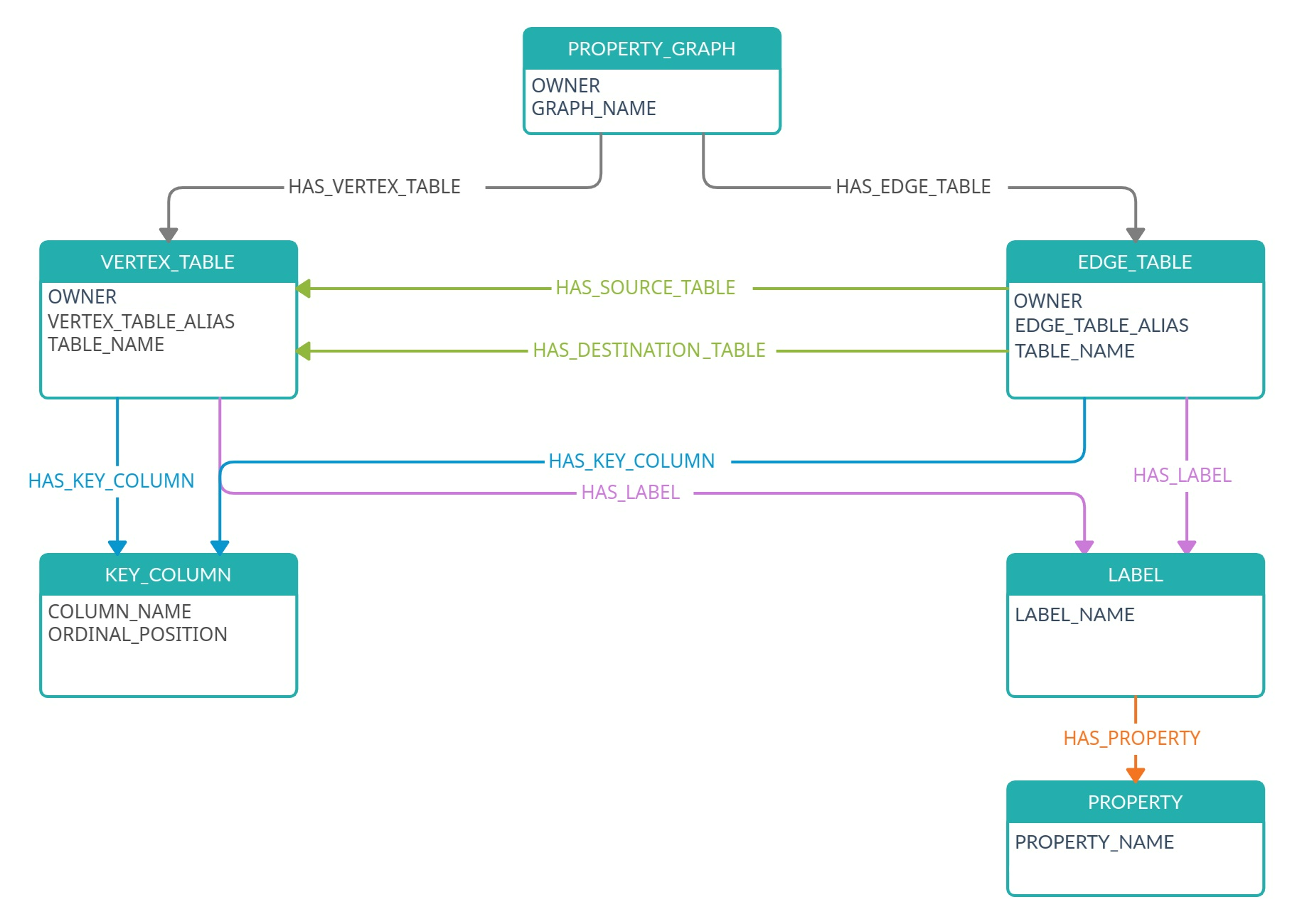9.1.1 Retrieving Metadata for PGQL Property Graphs
You can retrieve the metadata of PGQL property graphs created in the
database using the built-in PROPERTY_GRAPH_METADATA graph in your PGQL
queries.
The PROPERTY_GRAPH_METADATA graph structure including
properties is as shown:
Figure 9-1 PROPERTY_GRAPH_METADATA Graph Design

Description of "Figure 9-1 PROPERTY_GRAPH_METADATA Graph Design"
The following describes the preceding design of the metadata graph:
PROPERTY_GRAPH -[:HAS_VERTEX_TABLE]-> VERTEX_TABLE
-[:HAS_EDGE_TABLE]-> EDGE_TABLE
VERTEX_TABLE -[:HAS_KEY_COLUMN]-> KEY_COLUMN
-[:HAS_LABEL]-> LABEL
EDGE_TABLE -[:HAS_KEY_COLUMN]-> KEY_COLUMN
-[:HAS_LABEL]-> LABEL
-[:HAS_SOURCE_TABLE]-> VERTEX_TABLE
-[:HAS_DESTINATION_TABLE]-> VERTEX_TABLE
LABEL -[:HAS_PROPERTY]-> PROPERTYIt is important to note the following when using
PROPERTY_GRAPH_METADATA in PGQL queries:
- The
PROPERTY_GRAPH_METADATAgraph is automatically created and updated the first time you attempt to access it in a PGQL query. - The
PROPERTY_GRAPH_METADATAgraph is similar to a PGQL property graph and has its own set of metadata tables that describe its structure. In addition to the metadata tables for PGQL property graphs that are described in Table 9-1, the graph data forPROPERTY_GRAPH_METADATAis also stored in database objects that are listed in the following table:Table 9-2 Additional Metadata Tables
Table Name Description PROPERTY_GRAPH_METADATA_GRAPH_LIST$Metadata table describing the list of PGQL property graphs to which the current user has access PROPERTY_GRAPH_METADATA_EDGE_KEY_COLUMNS$Metadata table describing the edge key columns PROPERTY_GRAPH_METADATA_EDGE_LABELS$Metadata table describing the edge labels PROPERTY_GRAPH_METADATA_EDGE_TABLES$Metadata table describing the edge tables PROPERTY_GRAPH_METADATA_LABEL_PROPERTIES$Metadata table describing the vertex and edge label properties PROPERTY_GRAPH_METADATA_LABELS$Metadata table describing the vertex and edge labels PROPERTY_GRAPH_METADATA_VERTEX_KEY_COLUMNS$Metadata table describing the vertex key columns PROPERTY_GRAPH_METADATA_VERTEX_LABELS$Metadata table describing the vertex labels PROPERTY_GRAPH_METADATA_VERTEX_TABLES$Metadata table describing the vertex tables Note:
It is important that you do not alter or remove any of the metadata tables for thePROPERTY_GRAPH_METADATAgraph. - When running PGQL queries using the Java API, you must disable
autocommit on the JDBC connection (
conn.setAutoCommit(false)). This ensures thatPROPERTY_GRAPH_METADATAgraph gets created automatically.
The following examples show using PROPERTY_GRAPH_METADATA in
PGQL queries to retrieve the required metadata.
You can retrieve the list of graphs to which you have access as shown:
opg4j> String pgql =
...> "SELECT g.graph_name "
...> +"FROM MATCH (g:property_graph) ON property_graph_metadata "
...> +"ORDER BY g.graph_name"
pgql ==> "SELECT g.graph_name FROM MATCH (g:property_graph) ON property_graph_metadata ORDER BY g.graph_name"
opg4j> pgqlStmt.executeQuery(pgql).print()String pgql = "SELECT g.graph_name "+
"FROM MATCH (g:property_graph) ON property_graph_metadata "+
"ORDER BY g.graph_name";
PgqlResultSet rs = pgqlStmt.executeQuery(pgql);
rs.print();>>> pgql = '''
... SELECT g.graph_name
... FROM MATCH (g:property_graph) ON property_graph_metadata
... ORDER BY g.graph_name
... '''
>>> pgql_statement.execute_query(pgql).print()On execution, the preceding query produces the following result:
+------------------------+
| GRAPH_NAME |
+------------------------+
| BANK_GRAPH_VIEW |
| FINANCIAL_TRANSACTIONS |
| FRIENDS |
+------------------------+You can retrieve the vertex properties of a graph as shown:
opg4j> String pgql =
...> "SELECT p.property_name "
...> +"FROM MATCH(g:property_graph)-[:has_vertex_table]->(v)-[:has_label]->(l:label)-[:has_property]->(p:property) "
...> +"ON property_graph_metadata "
...> +"WHERE g.graph_name = 'FRIENDS' "
pgql ==> "SELECT p.property_name FROM MATCH(g:property_graph)-[:has_vertex_table]->(v)-[:has_label]->(l:label)-[:has_property]->(p:property) ON property_graph_metadata WHERE g.graph_name = 'FRIENDS' "
opg4j> pgqlStmt.executeQuery(pgql).print()String pgql = "SELECT p.property_name "+
"FROM MATCH(g:property_graph)-[:has_vertex_table]->(v)-[:has_label]->(l:label)-[:has_property]->(p:property) "+
"ON property_graph_metadata "+
"WHERE g.graph_name = 'FRIENDS' ";
PgqlResultSet rs = pgqlStmt.executeQuery(pgql);
rs.print();>>> pgql = '''
... SELECT p.property_name
... FROM MATCH(g:property_graph)-[:has_vertex_table]->(v)-[:has_label]->(l:label)-[:has_property]->(p:property)
... ON property_graph_metadata
... WHERE g.graph_name = 'FRIENDS'
... '''
>>> pgql_statement.execute_query(pgql).print()On execution, the preceding query produces the following result:
+---------------+
| PROPERTY_NAME |
+---------------+
| BIRTHDATE |
| HEIGHT |
| NAME |
+---------------+Parent topic: Creating PGQL Property Graphs on Oracle Database Tables